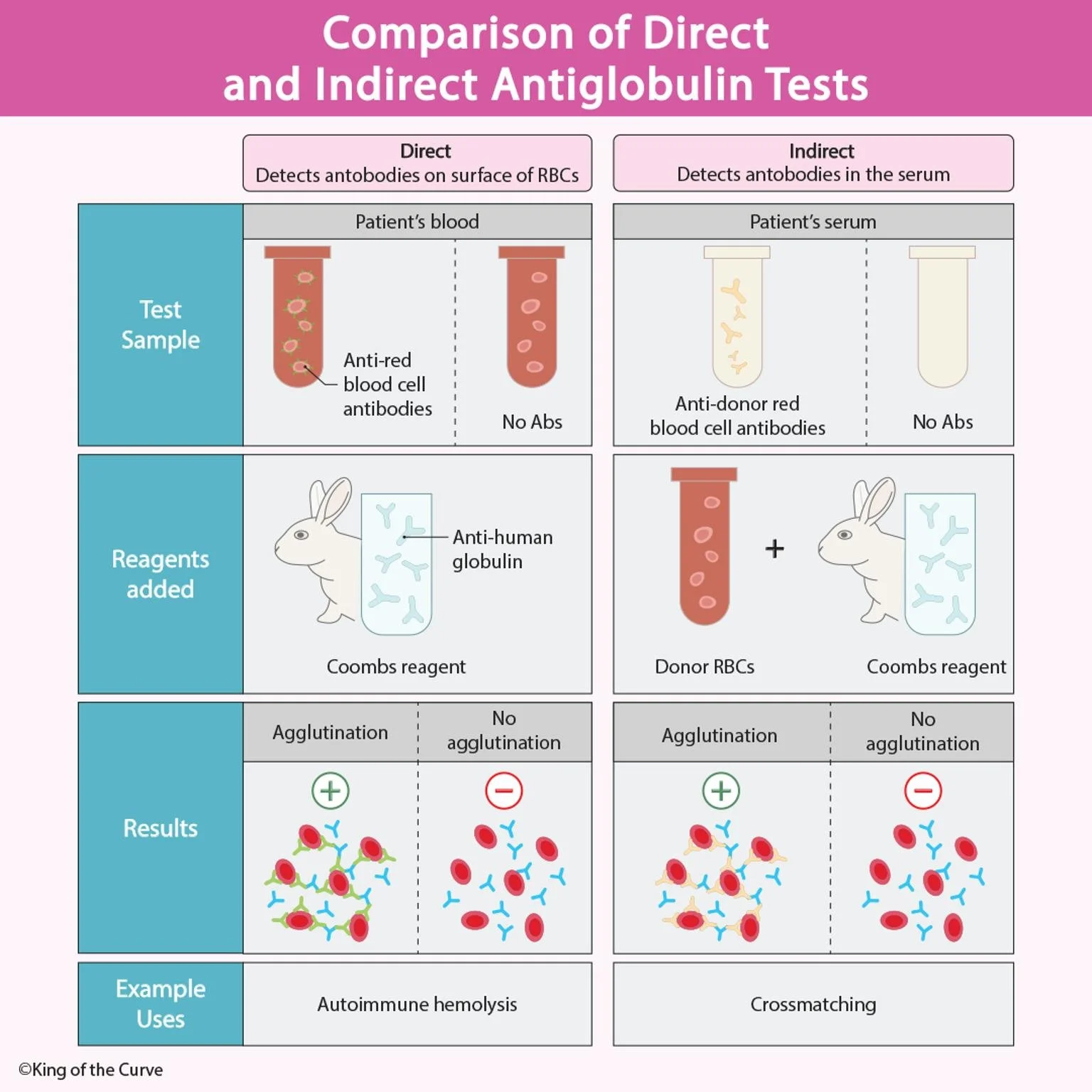🧪 Understanding Direct vs. IndirectAntiglobulin Tests (Coombs Tests)
The antiglobulin tests, also known as Coombs tests, are essential tools in immunohematology. These tests help detect the presence of antibodies that react against red blood cells (RBCs), either in the body or in a sample of serum. There are two main types of Coombs tests: Direct Antiglobulin Test (DAT) and Indirect Antiglobulin Test (IAT). Though they sound similar, they serve different clinical purposes and follow distinct methodologies.
🔬 What Is the Direct Antiglobulin Test (DAT)?
Purpose:
Detects antibodies or complement proteins that are already bound to the surface of red blood cells in the patient's body.
Sample Used:
Whole blood from the patient.
How It Works:
A blood sample is collected containing RBCs.
Coombs reagent (anti-human globulin) is added.
If antibodies are present on the RBC surface, agglutination (clumping) occurs, indicating a positive result.
Result Interpretation:
✅ Agglutination: Positive DAT – Antibodies are bound to RBCs.
❌ No Agglutination: Negative DAT – No antibodies bound.
Common Clinical Use:
Diagnosing autoimmune hemolytic anemia.
Monitoring hemolytic disease of the newborn or transfusion reactions.
🧫 What Is the Indirect Antiglobulin Test (IAT)?
Purpose:
Detects unbound antibodies against red blood cells in the serum—useful for anticipating immune reactions before they happen.
Sample Used:
Serum from the patient (without RBCs).
How It Works:
The patient’s serum is mixed with donor red blood cells.
Coombs reagent is then added.
If the serum contains antibodies targeting donor RBCs, agglutination occurs.
Result Interpretation:
✅ Agglutination: Positive IAT – Antibodies are present in the serum.
❌ No Agglutination: Negative IAT – No antibodies detected.
Common Clinical Use:
Crossmatching before blood transfusions.
Antenatal screening for Rh incompatibility.
Ensuring safe transfusions.
⚖️ Summary Comparison
| Feature | Direct Test (DAT) | Indirect Test (IAT) |
|---|---|---|
| Detects | Antibodies on RBCs | Antibodies in serum |
| Sample | Patient’s blood | Patient’s serum |
| Reagents Added | Coombs reagent | Donor RBCs + Coombs reagent |
| Result (Agglutination) | Indicates antibody-coated RBCs | Indicates free antibodies |
| Common Use | Autoimmune hemolysis diagnosis | Crossmatching for transfusions |
🧠 Final Thoughts
The Direct and Indirect Coombs tests play critical roles in diagnosing immune-related blood disorders and ensuring the safety of blood transfusions. While the DAT identifies problems already happening within the body, the IAT acts as a preventive screening tool. Understanding the nuances of each test is essential for medical professionals, students, and lab technicians alike.
Frequently Asked Questions (FAQs)
-
Aim for 4-6 focused hours, ensuring you incorporate breaks to avoid burnout.
-
Practice mindfulness techniques, take practice exams under realistic conditions, and maintain a balanced lifestyle.
-
Set short-term goals, seek support from mentors, and reward yourself for small achievements.
-
Regular exercise improves focus, reduces stress, and enhances overall mental clarity.
-
KOTC offers personalized learning tools, gamification features, and adaptive question banks to help students stay on track without burnout.


